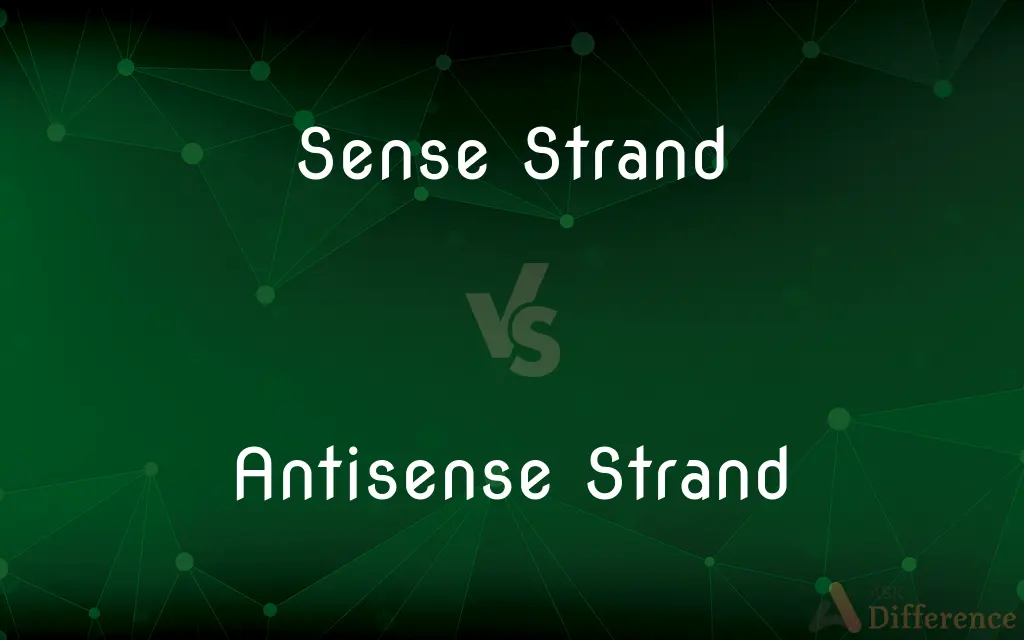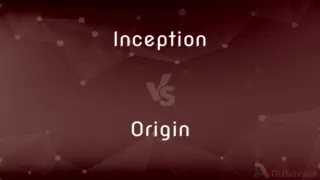Sense Strand vs. Antisense Strand — What's the Difference?
By Tayyaba Rehman — Published on October 29, 2023
The Sense Strand of DNA has a sequence matching the mRNA produced during transcription, while the Antisense Strand serves as the template for mRNA synthesis.

Difference Between Sense Strand and Antisense Strand
Table of Contents
ADVERTISEMENT
Key Differences
Within the context of DNA, the Sense Strand and Antisense Strand are complementary sequences. The Sense Strand, also called the coding strand, has the same sequence as the RNA produced, albeit with thymine (T) in DNA being replaced by uracil (U) in RNA. Conversely, the Antisense Strand, often termed the template strand, directly binds to RNA polymerase during the transcription process and serves as the template for mRNA synthesis.
Distinguishing between the Sense Strand and Antisense Strand is crucial for understanding gene expression. While the Sense Strand bears the same sequence as the resulting RNA (with T replaced by U), it's the Antisense Strand that actually gets "read" or "transcribed" to form this RNA.
Delving deeper, not all regions of the Sense Strand are represented in the final mRNA, as introns are spliced out. Nonetheless, this strand gives a straightforward representation of the genetic code. The Antisense Strand, however, is directly involved in the mechanics of transcription, providing the sequence from which the RNA is synthesized.
The terms Sense Strand and Antisense Strand can be seen as descriptors of function. While both strands carry vital genetic information, it's the Antisense Strand that's actively utilized during the transcription process. The Sense Strand, while not directly used, provides a sequence mirror to the produced RNA, minus the T-to-U substitution.
Comparison Chart
Also known as
Coding strand.
Template strand.
ADVERTISEMENT
Relation to mRNA
Matches mRNA sequence (with T replaced by U).
Serves as template for mRNA synthesis.
Direct Role in Transcription
Not directly transcribed.
Directly transcribed.
Complementarity
Complementary to the Antisense Strand.
Complementary to the Sense Strand.
Sequence Representation
Represents the genetic code straightforwardly (considering the T-to-U change).
Represents the "opposite" of the genetic code being expressed.
Compare with Definitions
Sense Strand
The DNA strand matching the mRNA's sequence.
The Sense Strand of a gene shows how the resulting RNA will look, considering T-to-U changes.
Antisense Strand
The DNA strand used as a template for mRNA synthesis.
The Antisense Strand is read by RNA polymerase to produce RNA.
Sense Strand
Not directly transcribed into RNA.
RNA polymerase reads the other strand, not the Sense Strand, during transcription.
Antisense Strand
Known as the template strand.
RNA synthesis uses the Antisense Strand as its guiding template.
Sense Strand
Complementary to the antisense strand.
Every base in the Sense Strand has a counterpart in the Antisense Strand.
Antisense Strand
Opposite in sequence to the resulting mRNA.
While the Antisense Strand has adenine, the mRNA will have uracil opposite it.
Sense Strand
Matches the final RNA sequence.
One can predict the RNA sequence by examining the Sense Strand and substituting U for T.
Antisense Strand
Not a direct match to the final RNA.
The sequence of the Antisense Strand will be the reverse complement of the RNA.
Sense Strand
Known as the coding strand.
The Sense Strand contains the code that's mirrored in the mRNA, though it's not the template itself.
Antisense Strand
Complementary to the sense strand.
Bases in the Antisense Strand pair with those in the Sense Strand.
Common Curiosities
Why is the Antisense Strand called the template strand?
Because it provides the sequence template for mRNA synthesis during transcription.
Do both strands code for proteins?
Generally, only one gene region (represented by one of the strands) is transcribed and subsequently translated into a protein.
Does the Antisense Strand have introns and exons?
Both strands have these regions, but it's the Antisense Strand that's read to produce pre-mRNA, which then undergoes splicing.
What's the significance of distinguishing between the two strands?
It aids in understanding transcription mechanics, gene regulation, and the functional implications of genetic sequences.
Which strand gets transcribed into RNA?
The Antisense Strand is directly transcribed to produce RNA.
Is the Sense Strand the same as the produced mRNA?
Almost. The Sense Strand matches the mRNA sequence, but with thymine replaced by uracil in RNA.
How does the Antisense Strand function?
The Antisense Strand serves as the template from which mRNA is synthesized during transcription.
Does the Antisense Strand have thymine?
Yes, DNA, including the Antisense Strand, contains thymine. Uracil is specific to RNA.
What is the Sense Strand?
The Sense Strand is the DNA strand whose sequence matches the mRNA produced, considering T-to-U changes.
How can I identify the Sense Strand?
The Sense Strand has a sequence that, with T-to-U changes, would match the resulting mRNA.
Why isn't the Sense Strand used as a template?
While the Sense Strand represents the genetic code, it's the Antisense Strand that's mechanistically involved in transcription.
In terms of polarity, how are the strands oriented?
They are antiparallel. If the Sense Strand is 5'-to-3', the Antisense Strand will be 3'-to-5'.
Are these terms used in RNA interference?
Yes, "antisense" can refer to RNA sequences complementary to the mRNA, inhibiting its function.
Can both strands be transcribed in different regions of the DNA?
Yes, depending on the genes present on each strand.
Can the roles of these strands switch in different regions?
Yes, depending on which strand carries the gene, their roles as sense or antisense can vary across regions.
Share Your Discovery

Previous Comparison
Inception vs. Origin
Next Comparison
DC Comics vs. Marvel ComicsAuthor Spotlight
Written by
Tayyaba RehmanTayyaba Rehman is a distinguished writer, currently serving as a primary contributor to askdifference.com. As a researcher in semantics and etymology, Tayyaba's passion for the complexity of languages and their distinctions has found a perfect home on the platform. Tayyaba delves into the intricacies of language, distinguishing between commonly confused words and phrases, thereby providing clarity for readers worldwide.
















































